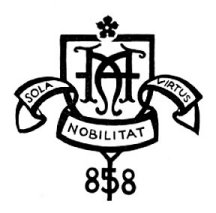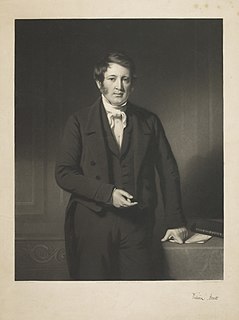
The Dean Cemetery is a historically important Victorian cemetery north of the Dean Village, west of Edinburgh city centre, in Scotland. It lies between Queensferry Road and the Water of Leith, bounded on its east side by Dean Path and on its west by the Dean Gallery. A 20th-century extension lies detached from the main cemetery to the north of Ravelston Terrace. The main cemetery is accessible through the main gate on its east side, through a "grace and favour" access door from the grounds of Dean Gallery and from Ravelston Terrace. The modern extension is only accessible at the junction of Dean Path and Queensferry Road.

The Belfast Royal Adacemy is the oldest school in the city of Belfast, Northern Ireland. It is a co-educational, non-denominational voluntary grammar school situated in north Belfast. The Academy is one of 8 schools in Northern Ireland whose Head is a member of the Headmasters' and Headmistresses' Conference

The Church of Saint Andrew and St Paul is a Presbyterian church in downtown Montreal, Quebec, Canada. It is located at 3415 Redpath Street, on the corner of Sherbrooke Street. It is in close proximity to the Golden Square Mile, the Montreal Museum of Fine Arts, Concordia University as well as the Guy-Concordia Metro station.

John G. Mossman was one of a number of English sculptors who dominated the production and teaching of sculpture in Glasgow for 50 years after his arrival with his father and brothers from his native London in 1828. His father William Mossman (1793–1851) was also a sculptor, and a pupil of Sir Francis Chantrey. He was trained both by his father and under Carlo Marochetti in London.
The High School of Glasgow is an independent, co-educational day school in Glasgow, Scotland. The original High School of Glasgow was founded as the choir school of Glasgow Cathedral in around 1124, and is the oldest school in Scotland, and the twelfth oldest in the United Kingdom. On its closure as a selective grammar school by Glasgow City Corporation in 1976, it immediately continued as a co-educational independent school as a result of fundraising activity by its Former Pupil Club and via a merge by the Club with Drewsteighnton School. The school maintains a relationship with the Cathedral, where it holds an annual service of commemoration and thanksgiving in September. It counts two British Prime Ministers, two Lords President and the founder of the University of Aberdeen among its alumni.
John Glencairn Carter Hamilton, 1st Baron Hamilton of Dalzell (1829–1900), was a Scottish soldier and politician.

The Rev. Dr. Robert Blair DD VD was a Scottish minister and a Gaelic scholar.

Hamilton Academy was a school in Hamilton, South Lanarkshire, Scotland.

William Brodie was a Scottish sculptor, working in Edinburgh in the 19th century.
William Cotton Oswell was an English explorer in Africa and other areas.
The 1873–74 Home Nations rugby union matches was a single international friendly held between the England and Scotland national rugby union teams. With no other recognised rugby union teams in Britain or the rest of the World, the encounter between Scotland and England represented the only possible match that could be arranged, and would continue as such until 1875, when Ireland formed a national team.
Rev Prof Islay Burns DD (1817–1872) was a 19th century Scottish theologian and writer.

Rev William Arnot (1808–1875) was a Scottish minister and theological writer.
Very Rev Dr David Brown DD LLD was a Free Church of Scotland minister who served as Moderator of the General Assembly 1885/86.
James Lyall was a Presbyterian minister in the early days of Adelaide, South Australia.
Very Rev Dr Robert Buchanan DD (1802–1875) was a 19th century Scottish minister and historian who served as Moderator of the General Assembly to the Free Church of Scotland in 1860/61. He was one of the leading figures in the Disruption of 1843.
Very Rev Dr Alexander Neill Somerville DD (1813–1889) was a 19th century Scottish minister and evangelist, who served as Moderator of the General Assembly for the Free Church of Scotland 1886/87. Glasgow University called him "Missionary to the World".
Rev Prof Allan Menzies DD (1845–1916) was a Scottish minister remembered as a religious author and translator. He was fluent in both English and German.

















